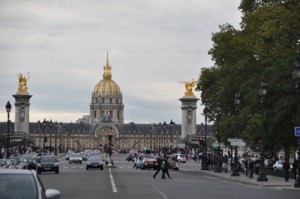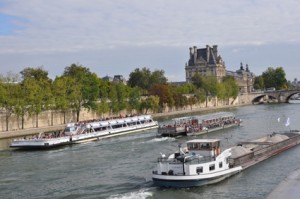Paris Pockets Packed with History
In his grand tome entitled Paris, Edward Rutherfurd describes the site on the Left Bank where the Romans established their town, named Lutetia, as “a low, flat hillock, like a table overlooking the water”. Here on this gentle rise of land, they had laid out their town, building a large forum and “the main temple covering the top of the table.” Even back then, its colloquial name was the city of the Parisii, after its original people.
I know none of this as my travelling companion and I traipse up the last 100 metres of the so-called gentle hillock dragging our cases to our hotel, L’hotel Sainte-Genevieve. Things are not going well for the start of our six day holiday in Paris. The road is blocked for the annual Patrimione Day and the taxi has had to leave us half way up the hill because it seems the schools in the Latin Quarter have open days. We find the number 17 on Rue Descartes, but there is no hotel sign, simply the large numbers alongside a pair of those huge ornate timber doors, which so characterise Paris. Voila! There is an entry button and when I press it, one of the doors swings slowly open and we proceed into a courtyard. Our accommodation is indeed a discreet hotel for French army personnel and their families. So in this unassuming place, we begin an exciting week of living like the locals on the Left Bank in Paris – coming and going through those huge carved doors which once opened to horses and carriages in the 19th century.
Even though this quaint curved rue is named after the great French philosopher Descartes, it is highly likely that Roman chariots took this route as they charge up the hill to the old Roman hilltop town 2000 years ago. More significant is that Saint Genevieve herself, the patron saint of Paris, would walk daily up the same road we are on now to the Abbey Sainte-Genevieve , which was named in her honour. The route, too, where the taxi stopped is named in her honor as Rue de la Montagne-Sainte Genevieve. At Place Larue it becomes Rue Descartes.
so do the streets. The abbey, built in 502 by King Clovis I was ravaged by the Normans in 857 and when it was rebuilt in the 11th century it became a monastic empire. It is a thrilling find that the first saint of Paris was a devote woman, who walked this same way every day to pray.
This is my first holiday in Paris since my husband Olivier passed away 16 months ago and I thought I knew everything important about the City of Lovers. It is also my first overseas holiday with a girlfriend. Jane has never been to Paris and I hope she will be as gobsmacked by its beauty as I was nine years ago. Without a Frenchman to drive me around this glorious city, we do what other tourists do, buy a two-day pass on the REd Bus with its open top upper deck. This is the most economical way to get your bearings on the enormity of Paris from one’s high perch.
The slow bus drawls around the quays and boulevards stopping intermittently for tourists to alight or board at any of the wondrous iconic buildings of Paris, the Eiffel Tower, Notre Dame, Le Louvre, La Madeleine, Les Invalides, Conciergerie, the magnificent Alexander III bridge over the River Seine, the Opera House and the Arc de Triomphe . It is a leisurely, pleasurable way to soak up the history of this ancient city indelibly written on the buildings we pass. The Champs Elysees is Paris’s prime high end shopping precinct and there is always a river of people on either side. On the one side Guerlain is being renovated, clothed behind a “wall” of printed partitions and on the other side, that temple of luxury, Louis Vuitton spreadeagles around one whole corner. Our English recording of Paris’s history (there are nine different languages) adds to the beauty before our eyes and ignites our curiosity.
The Left Bank (Rive Gauche) offers quite a different side of Paris to the Right Bank, (Rive Droite). On Day 3 when we turn the corner from our hotel in search of La Poste we find the awesome Pantheon on one side of the street – and just as impressive, the ancient L’Eglise Sainte Genevieve on the other. Our hotel, as is the church, is named after Paris’s first heroine, the woman who inspired the citizens in the early city of Paris in the 6th century to rise up and defeat Attilla the Hun. We walk on a little further, and there it is, the hub of the student quarter – the Sorbonne – the University of Paris. No wonder students pour like gushing wine from the Metro in the morning and now they are lined up outside almost every doorway we pass awaiting entry for classes.
Under our very noses, we have discovered the other Paris, the antithesis of the rich two-mile stretch of the Champs Elysses, the student quarter. No wonder the street where we traipse each evening towards our hotel is named Rue des Ecoles (street of the schools) because it seems there is an ecole or lycee (high school) at every corner. We are walking very famous streets because Rue St Jacques, which heads straight down to the River Seine, was once the Pilgrims’ Way to the Compostale in Spain.
There is a trick to travelling with a trusted friend, mostly learnt through trial and error.. To know and love Paris as I do is his lovely legacy.
To ensure peace and harmony, here are a few tips which helped us enjoy Paris without impinging on each other’s sense of adventure, n0t forgetting fashion shopping, which is tedious for the onlooker.
1. Begin your holiday by taking a trip on the tourist bus and follow your course with a quality map of the city. The bus operator provides one, but I bought a plastic-covered one from The Map Shop on Unley Road.
2. Write all details of your hotel, address, telephone number and the route to it from a landmark (ours was Café Panis) into your diary or travel notebook. Keep it on you at all times. Take mobile number of your travelling companion.
3. Synchronise times on your watches and if making a meeting point, mark it on each map with a big red circle. Always be on time to avoid panic attacks.
4. Visit Shakespeare and Company – the bookshop in Paris filled with English language books on Quai Montebello.
5. Check out the Metro if you wish to use it and it is the cheapest and most efficient way of moving around Paris. Personally I prefer taxis in such a beautiful city as I never tire of studying the buildings, which reflect centuries of architecture.
6. If in Paris for the first time, book a river cruise to learn the intriguing history of the bridges which cross the River Seine. A meal on board is wonderful.
7. Check out the tours offered through your hotel – use up the specials offered through the open deck tourist buses.
8. To get your bearings on the left and right banks of the city, take a taxi trip from the Latin Quarter on the Left Bank to the posh Right Bank. Pick one up on the corner of Boulevard Saint Michel on the quai and ask to be taken along Rue de Rivoli to the Marius (Place des Vosges has dramatic Parisian buildings) and then return along Rivoli to the Place de la Concorde turning right into Rue Royale with the magnificent La Madeleine in front of you and get off at Rue Faubourg St Honore for an hour’s “promenade” on this famous shopping precinct of Paris. To your left is the high end of Paris fashion and to your right don’t miss Place Vendome (look for the central column) for exquisite jewellery stores and the Ritz Hotel, but continue along St Honore (stopping for coffee at Place Du Palais Royale) towards Rue du Pont Neuf where you will find one of the many “villages” which make up Paris. This was the part of Paris I described in my book From France With Love.
9. Other special pockets of Paris are St. Germain des Pres to see the oldest church in Paris and also the two famous cafes of French existential writers Simone de Beauvoir and Jean-Paul Sartre – Café de Flore and Les Deux Magots on Boulevard St Germain and wander down Rue Bonaparte for an interesting mix of shopping experiences; and at Montmartre are its two distinct – but very different attractions – Moulin
Rouge and the magnificent white L’Eglise, Sacre Coeur. Take a walk from the Butte to discover its fascinating web of streets, stairs and squares rather than the funicular.
10. Lastly, my musts list includes Jardin du Luxembourg for the statues of the queens of France, the exquisite Sainte-Chappelle on Ile de Cite, and Musee du Louvre, but remember it is closed on Tuesdays and across the river, Musee d’Orsay is closed on a Monday.
RSS feed for comments on this post. TrackBack URI







